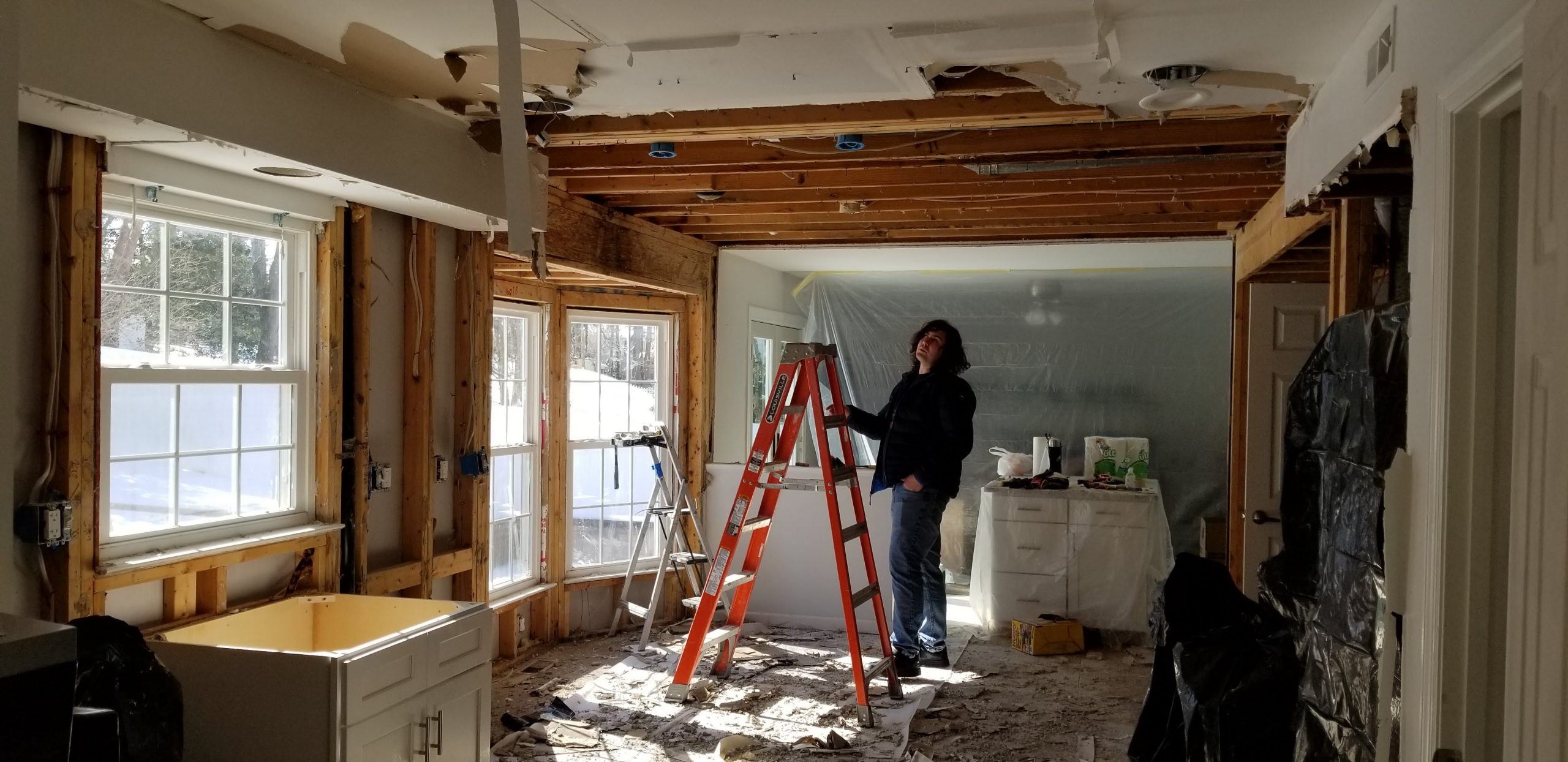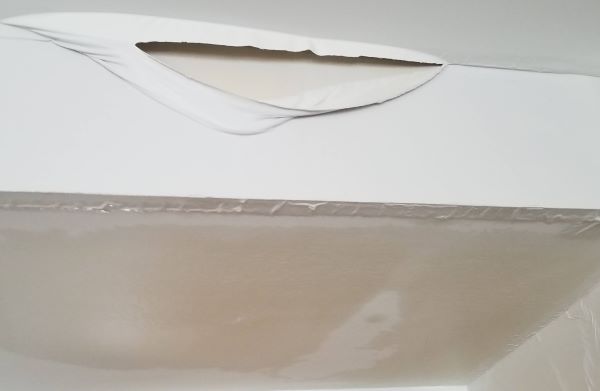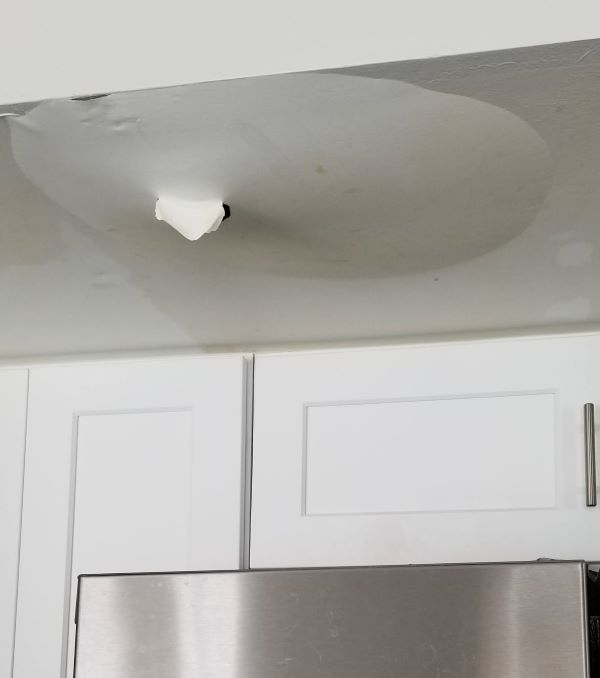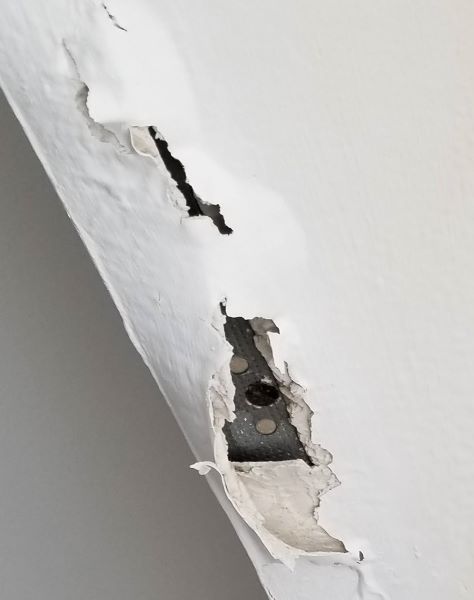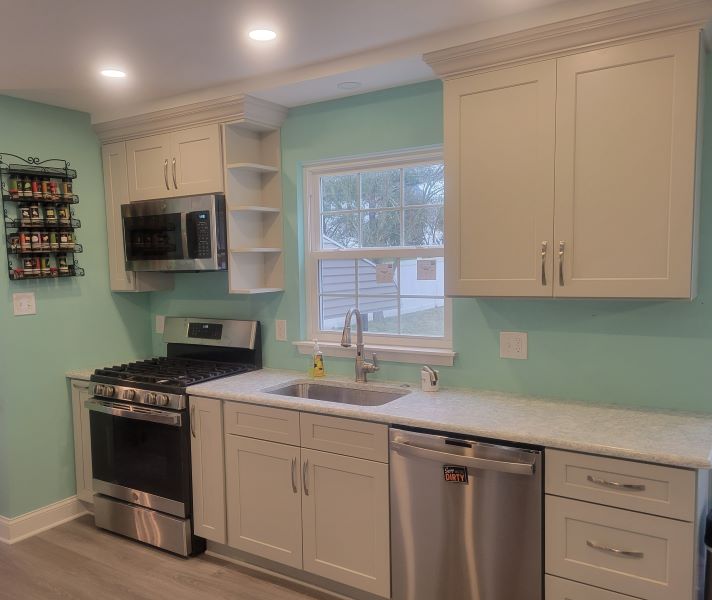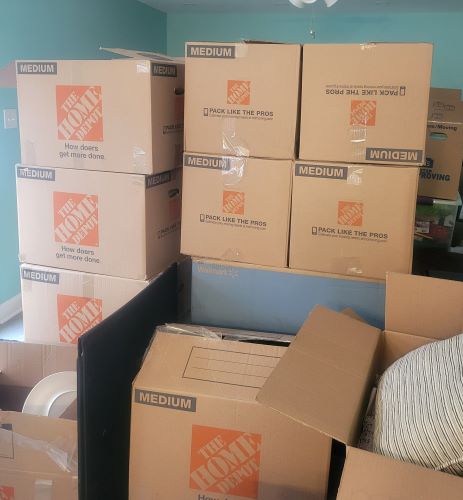Editor’s Preface: With the breakout success of Chip and Joanna Gaines’ FIXER UPPER program, flipped homes look more appealing than ever. Today’s homebuyers are likely to let their guard down when purchasing flipped houses, and people investing in house flipping may not appreciate the importance of using contractors that know what they’re doing and have integrity. This story is a cautionary tale of what can happen when there are dangers and poor quality of work hidden beneath the stylish finishes in a flipped home.
The gorgeous flipped house I bought had a catastrophic leak that caused $200,000 in damage and also drove me from my home for almost a year. Here’s my story and what I’d do differently.
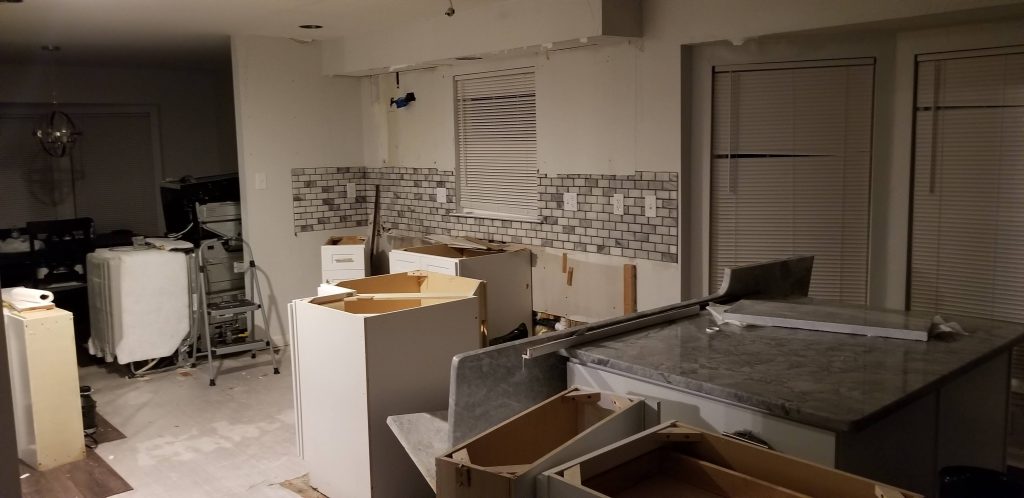
Take-Home Lessons:
In the aftermath of the catastrophic leak that devastated the flipped house I bought, here’s what I did right and what I’d do differently:
- Do make sure you have homeowners insurance in an amount sufficient to rebuild and replace your home and belongings in the event of a major loss.
- Do hire a public adjuster to make sure you get the full amount of insurance money you’re entitled to.
- Do make sure you hire a licensed, insured, knowledgeable contractor you trust to handle a rebuild (or any renovation), and get any permits required to do the work legally.
- Do expect the insurance claims process, the settlement disbursement process, the permitting process, and the construction process to take a lot of time.
- Don’t buy a flipped house without realizing that there could be a lot wrong behind the walls, where you can’t see.
- Don’t assume that an inspection by a thorough home inspector is enough to put you in the clear.
- Do insist on seeing the permits if you buy a flipped home.
- Do invest in a smart water detection system. (It just might save your home.)
It happened overnight—literally. If it hadn’t, the damage would have been so much less extreme.
My husband and I woke up to a nightmare. “Rain” spilled from the ceiling. Wrinkles were setting in water-logged drywall. Throughout the house, sheetrock was bubbling, collapsing and peeling away from beams and framing.
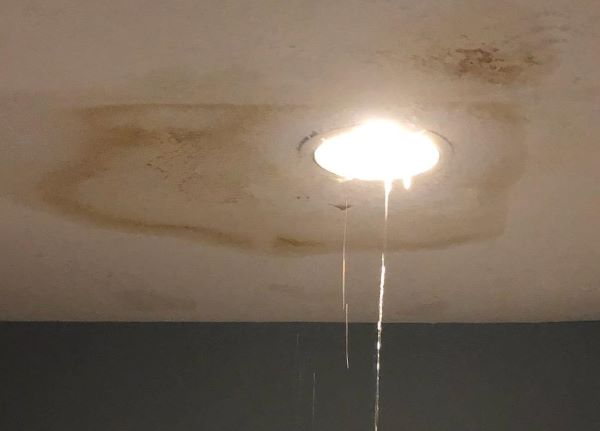
Water was everywhere: inside the kitchen cabinets, the light fixtures, the microwave, the walls.
In a matter of hours, while we slept, the flipped house we had purchased went from being our home to being a soggy, dripping demolition site.
It would be almost a year before our family could finally go home again.
Our Story of a Catastrophic Leak
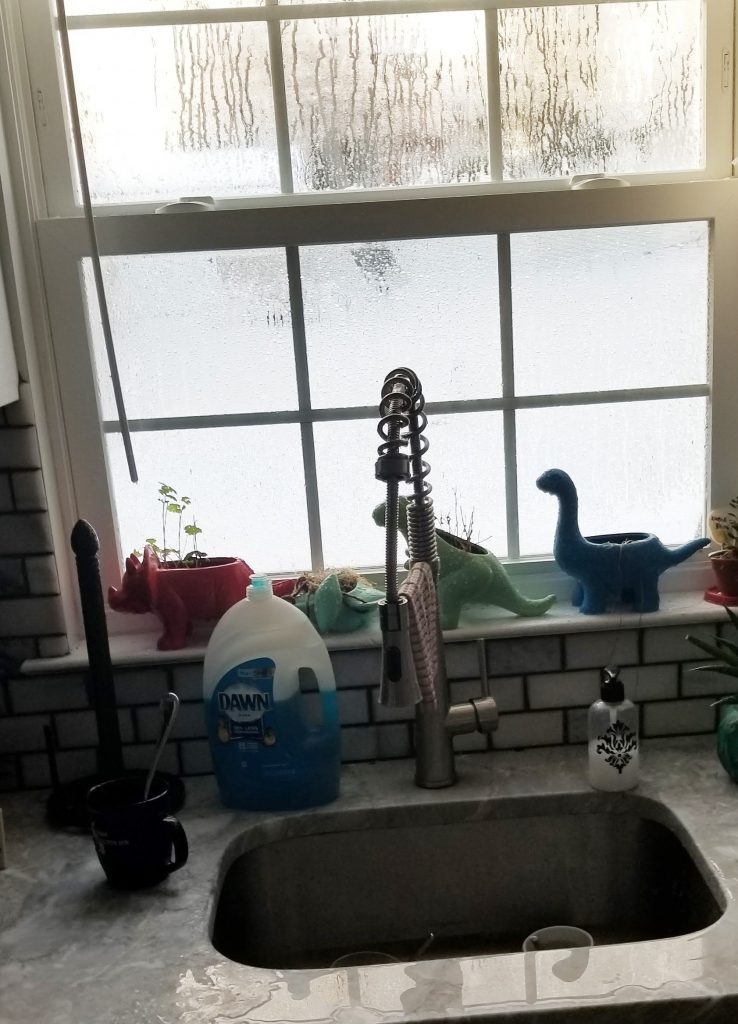
Just after 6 a.m. on Saturday, February 20, 2021, I stepped into our master bathroom and stopped short.
The low rushing sound that bothered me wasn’t all that alarming, but it was unusual. I listened. The noise didn’t stop. I woke my husband, who followed me into the bathroom to listen, too.
“That’s water,” he said.
The second we stepped out into the hallway to investigate, our feet went squish-squish on the sodden carpet.
My husband started pulling down the trapdoor of the attic, afraid the snow on our roof had somehow leaked into the house. I opened the door to the second-story hallway bathroom. The tile floor was soaked and slippery, but no water was coming out of the faucet. I pulled open the vanity cabinet. Water gushed uncontrollably from underneath the sink.
My husband ran down to the basement to shut off the water to the house. It was a surreal race through raining kitchen lights and crumbling drywall. The windows were so fully covered in condensation from the inside that you couldn’t see outside. The water had slunk through the walls and the ceilings to destroy the inside of our home all the way down to the basement.
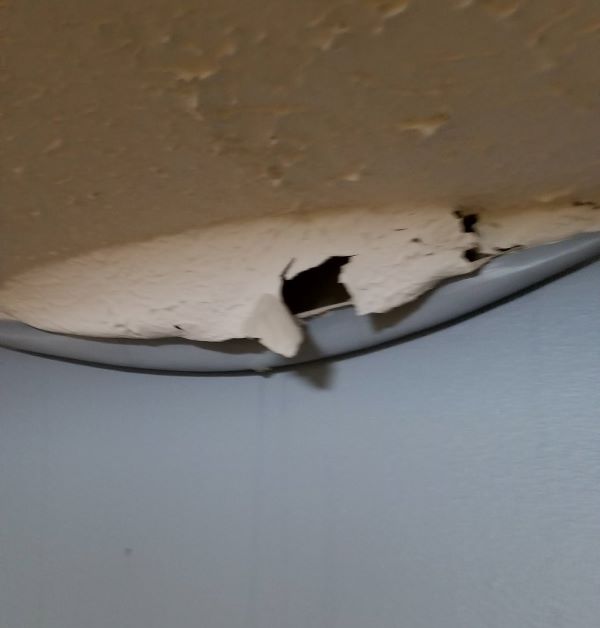
I called a public adjuster who had helped us once before with a house-related matter that now seemed so small in comparison. The adjuster picked up right away and promised to have a team on-site in a little over an hour. In the meantime, we tried to catch the worst of the drips in buckets and bins, to wet-vac floors that had already been saturated, and to use what dry towels we could find to try to dry off things that could be moved.
The problem was, there was almost nowhere to move them to. There wasn’t a single room in the home that didn’t need some sort of repair.
As promised, a restoration crew, along with the adjuster and other professionals, arrived. Some of them said, “Sorry for your loss,” as they walked through our home, snapping photos or getting their hands dirty—ripping out kitchen cabinets and backsplash tiles or pulling up carpet so wet that it could have been wrung out like a washcloth.
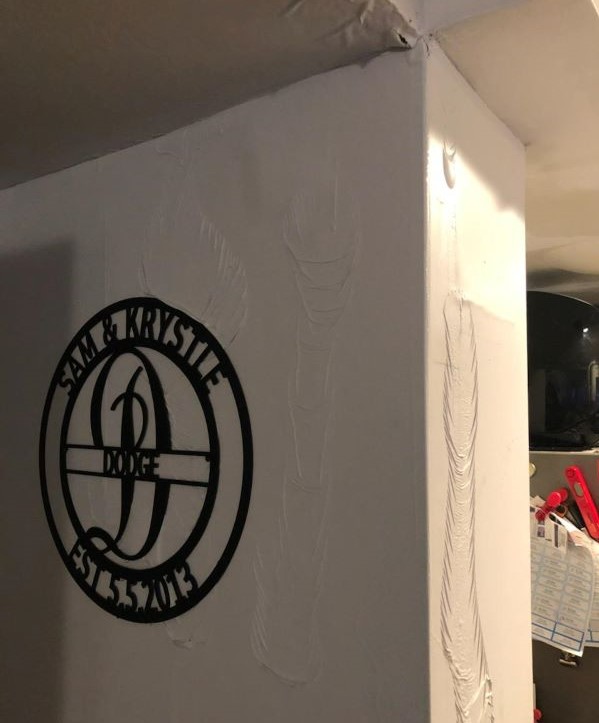
Some of them told us our situation was one of the worst they’d seen in their careers. It was at once depressing and validating: a surreal parade of strangers helping us by tearing apart what was left of our home.
Everything was filthy, covered in water that had mixed with soggy drywall as it streamed downward through the house. The irony was that, with the water shut off, we couldn’t wash anything, even our hands.
The day seemed to last for ages, but at the same time, the hours left to get done the urgent and unexpected work of packing up our entire home flew by. Only after the crew left for the night did I realize why it was so cold: the water had flooded our HVAC system, and the heater was no longer working. We worried about what would happen if another pipe burst from the freezing temperatures—until our public adjuster told us it couldn’t get much worse. We packed a bag of clothes and essentials for the first of many nights away from home.
Based on the water usage bill we received later, our best guess is that between 6,000 and 7,000 gallons of water leaked throughout our home that night, over the course of, at most, 10 hours.
Searching for a Reason
“How could this happen?” we wondered as we watched our kitchen cabinets be torn off the wall and the floorboards warp so that they resembled waves in the ocean.
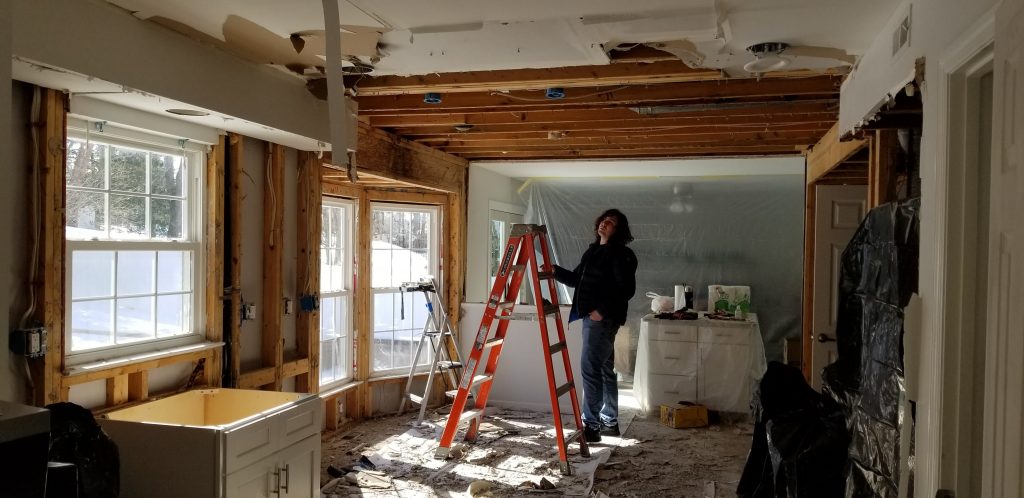
“Why did this happen?” we asked each other, with no answer, as we sorted through our damp possessions to determine what could be salvaged and what was now a risk for harboring mold growth or starting an electrical fire. Dishes could be washed, but soaked kitchen appliances—like the slow cooker I’d gotten for my bridal shower and our well-loved KitchenAid mixer—had to be tossed.
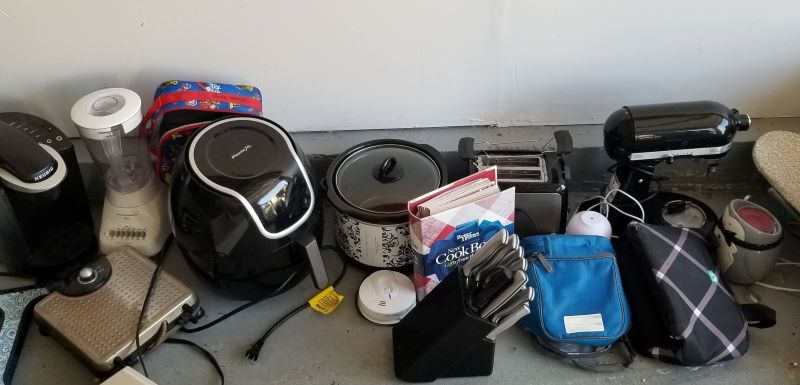
Weeks later, we had our answer. The insurance company sent an engineer to examine the pipe that had burst. As he studied what was left of the plumbing that had once been under the sink—back before the vanity had been pried from the wall and the ruined sheetrock removed—the engineer told my husband that the hose attached to that pipe was entirely too long and had been wrapped around in a way that no licensed plumber would have done.
It was, he said, a “ticking time bomb.” Every time we turned on the faucet, it put more pressure on the hose and the pipe that would inevitably burst.
In the almost two years we’d lived in the home, we’d never touched the plumbing. Why would we? The house was a flip, bought move-in ready. We knew this work had been done under the company that flipped the home. The bathroom that became the epicenter of the devastation was one of the “all new luxury designed, custom tiled baths” that the professional house flipper had so proudly bragged about in the listing.

More Problems Hidden Behind the Walls
By the time the rip-out was complete, most of our first-story and basement areas of the house were down to the beams. Exterior walls and subfloor was all that was left of much of our home. That was when we learned the awful truth: the pipe that had caused the catastrophic leak was only one example of the dangerous, illegal, and substandard work that had been done by the people who flipped our home.
“I know you don’t want to hear this, but this may be a blessing in disguise,” said one electrician, as he pointed out the numerous instances of dangerous wiring that had been hidden in the walls. A catastrophic leak was terrible, but an electrical fire that could have physically harmed our family would have been even worse.
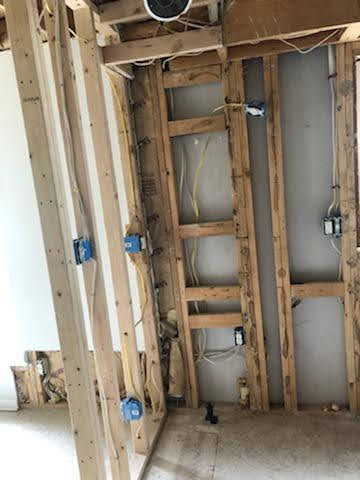
We hired a plumber to check everything. He showed us all the places previously hidden behind drywall and ceiling where the flipper had, again, installed the plumbing in a way no licensed plumber would. We paid out of pocket to fix all of it, thousands of dollars not included in the insurance claim.
With the walls and ceilings open, a patch of water-damaged subfloor underneath the master bathroom caught our attention. Aside from the loss of some damp sheetrock on the wall adjoining the bathroom where the leak occurred, this room had been unaffected by the leak. Yet the water damage was unmistakable.
It could have been old damage from before the shower was replaced, our contractor said, but he had a gut feeling it wasn’t. He recommended a water test that would allow us to see if the base of the shower leaked when filled with water.
The test was supposed to take place over the course of days. The leak became obvious within half an hour.
That “all new luxury designed, custom tiled” shower that the flipper had positioned as a selling point of the home had been installed with fatal flaws. The only way to fix it was to rip it out—not just the tile work but everything—and rebuild it all over again, from the base up. Insurance would cover nothing of this cost. As it was, the shower was unusable, since we now knew that any further use would damage the floor beneath it and (once the renovation was done) the ceiling of the room below.
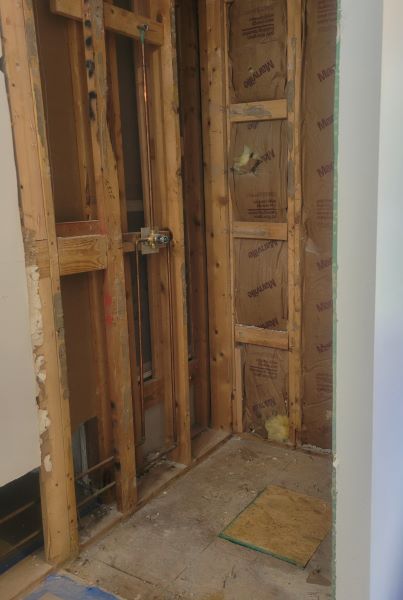
We debated going with a cheaper fix. If we put in prefabricated fiberglass walls, we might be able to save a little bit of money, but we still had to pay to rip everything out and rebuild the base from scratch. We’d planned on this house being our “forever home,” so going with the cheaper option as a temporary fix would cost us even more money in the long run.
In the end, we decided to take on another large and unexpected cost of several thousands of dollars now, since it made more sense in our situation than the alternative.
I’d like to think of all this expense as paying for peace of mind. Now that nearly all of the walls (at least, the ones put up by the people who flipped our home) have been opened and their secrets exposed, we know for sure that all of the work in our home has been done legally, safely, and correctly, by licensed contractors who actually know what they’re doing.
But with these out-of-pocket costs climbing well above $15,000 just to get back what we had—not upgrades for things that we just happened to want—it’s a high price tag for the peace of mind of knowing that our flipped home has basically been “unflipped.”
50 Weeks Away From Home
Our home had become uninhabitable overnight. We rented a room from family, moving in only what we needed and packing most of our possessions in a metal storage pod that took up half our driveway. We racked up thousands of miles of additional commuting, since our new temporary home was nearly an hour from our house, our son’s school, and my husband’s work. All this time, we had to pay the mortgage on a house we couldn’t live in, plus rent, plus these extra commuting costs. The insurance company would pay us back eventually, we were told, but in the meantime, our savings dwindled.
You know how, at the end of a long day, you can’t wait to go home? We felt that homesickness acutely, daily. Over the next weeks, we spent countless hours boxing up everything we owned in a house that, lacking insulation, was now no warmer than the winter weather outside. Work, worry, and dealing with this nightmare of a flooded house became our lives. I couldn’t sleep, agonizing over how we could possibly fix it all and get our life back. Our public adjuster, thankfully, handled things with the insurance company, so at least that didn’t take up our time.
My entire life was in disarray, and my mind felt constantly cluttered and unable to concentrate on anything. All I wanted was to go home, but I couldn’t—not when the stress caused an outbreak of shingles or when I was recovering from surgery in May.
“I miss home,” my three-year-old son would say. “I miss my toys. I miss my bed.” He’d ask, over and over, to hear the story of what happened to our home, his preschooler’s mind trying to make sense of something that my adult mind couldn’t even grasp. There’s no playbook for guiding your child through a months-long displacement from home in the middle of a global pandemic. It broke my heart that I wasn’t able to give him the security of home or even a promise of when we could go back.
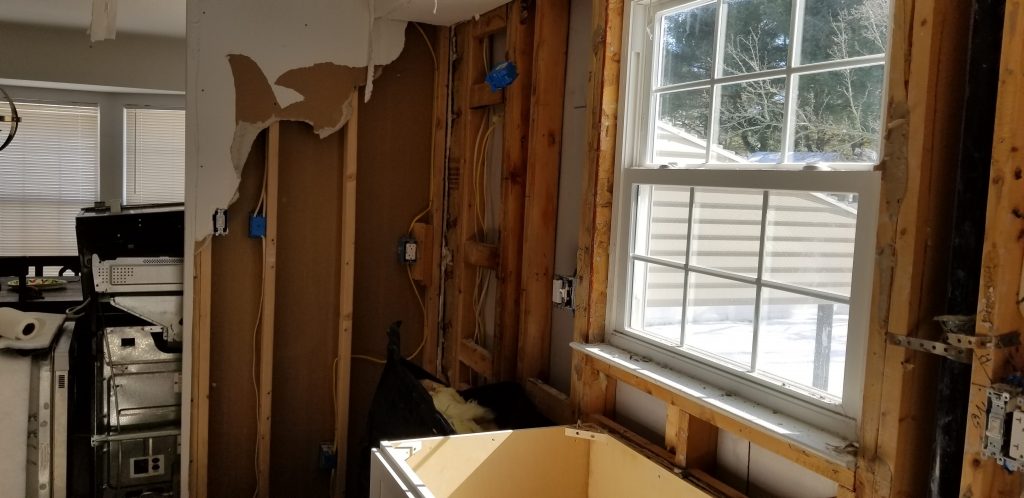
We missed the important things about being home, the ones that aren’t “things” at all: planning an Easter egg hunt, throwing barbecues, playing in the sprinkler on summer evenings, holding my son’s fourth birthday party, decorating for Halloween, hosting Thanksgiving dinner, and putting up our Christmas tree. My parents, who we lived with during this time, couldn’t possibly have done more to help us feel welcome. All the same, we longed to be home.
We tried to see the silver linings. We had more time with family, especially after the previous year’s lockdown. By the time the work was done, we would basically have a whole new house. The thing is, we didn’t want a whole new house. We certainly didn’t need one.
It wasn’t like we’d taken for granted the home we’d had. Since we’d moved in during March 2019, we frequently talked about what we loved about our home, especially since we’d spent so much time there during the pandemic. My son loved the space to run and play, which we didn’t have in the small house we’d lived in when he was born. I loved cooking in the open-concept kitchen and the cheerful natural light that streamed through the plentiful windows. My husband adored the finished basement that he’d turned into a “man cave” and game room.
The well-meaning but breathtakingly misguided assertions that we were “lucky” to get to renovate—as though we had won some kind of sweepstakes, not suffered a major loss that had cost us tens of thousands of dollars out of pocket—quickly got old.
I stressed about paying the costs of rent on top of the mortgage and usual expenses. I stressed about time. I dreaded eventually dealing with the logistics of a rebuild and then, even later, having to move back into our home all over again, knowing the chaotic way we’d had to pack everything we owned with no notice.
The insurance company dragged their feet. It took them over three months to offer a settlement. When they finally did, the money went straight to our mortgage company, not to us.
To get the money disbursed so we could start the renovations, we had to go through even more red tape with the mortgage company. We dug deeper into our diminishing savings to give the contractor a down payment to get started and at least begin applying for construction permits.
Not until mid-November did our home have interior walls again. Between the delays with the insurance company, our mortgage company, and the township, it truly seemed like we would never get home again.
Covid, too, slowed everything down. Materials didn’t arrive as expected. Installation teams suffered outbreaks that disrupted the job for weeks. There were delays that were no one’s fault, but that still kept us out of our home. We eventually stopped hoping to be home for Christmas… and then for New Year’s…
The first weekend in February 2022, we finally moved back in. It had been precisely 50 weeks since we woke up to a gushing pipe, mushy carpet, warping cabinets, and sagging drywall.
The work wasn’t completely done still, with certain materials delayed for an undetermined amount of time, but the house was livable. We were still waiting on both the last of the renovation money from the mortgage company and the additional living expenses from the insurance company. There were boxes everywhere, most of them packed with the random urgency that made it impossible to plan a smooth move back in.
But for the first time in nearly a year, we were finally home.
What I Did Right… And What I Wish I’d Known
We Had Homeowners Insurance…
Let’s start with the good: having homeowners insurance saved us from complete financial ruin.
The total claim is still being tallied, since we haven’t been paid back for our additional living expenses, but it’s certainly above $200,000, all told. If we didn’t have homeowners insurance, we would have lost everything. There would be no way we could have afforded to rebuild our home.
… But Our Insurer Sent a Non-Renewal Notice
Unfortunately, the insurance industry punishes you for bad luck. Even though the engineer determined that the plumbing work was improperly done and the insurance company indicated that it intended to pursue legal action against the company that flipped the home, the insurer dropped us.
It’s difficult and expensive to get insurance coverage after a major claim like this. We had to go through an alternate policy writing process, and we’re paying twice as much money for, by many metrics, less coverage. It’s one more cost we have to bear for the careless actions of the house flipper.
We will eventually be eligible for regular homeowners insurance plans again in a few years, as long as there are no more claims. There’s nothing we could have done to avoid this outcome of being dropped, other than having never bought the home in the first place. Still, it would have been nice not to have been blindsided by a non-renewal notice just weeks before our coverage would end.
We Hired a Public Adjuster…
Calling a public adjuster is one of the best decisions we made in the aftermath of our catastrophic leak. I had no idea what would go into the claim. Hiring a professional whose job is to know what claims are worth and fight to get that amount benefitted us a great deal.
A lot of people don’t know what a public adjuster is. I didn’t know, either, until the plumber we had hired to fix our malfunctioning sump pump a couple years ago recommended we call a public adjuster for help with a flooded basement.
A public adjuster is a licensed professional who members of the public (policyholders) can hire independently to negotiate with their homeowners insurance company on their behalf to resolve a claim.
There are two main benefits to hiring a public adjuster:
- This person is an expert on calculating the value of claims and negotiating payouts, so they are generally able to get their clients significantly more money than a policyholder would get on their own; and
- The public adjuster handles the whole claims process for you, which saves you the time and frustration at a time that, I can say from experience, you really don’t have extra time or energy to spare.
Public adjusters typically don’t charge clients upfront. Instead, they get paid a certain percentage of the claim. We didn’t have to pay anything out of pocket for an adjuster to show up early on a Saturday morning with a crew ready to start ripping out the damaged walls, floors, and ceilings. All we ever paid for the adjuster’s help was a portion of the payment(s) he got us from the insurance company.
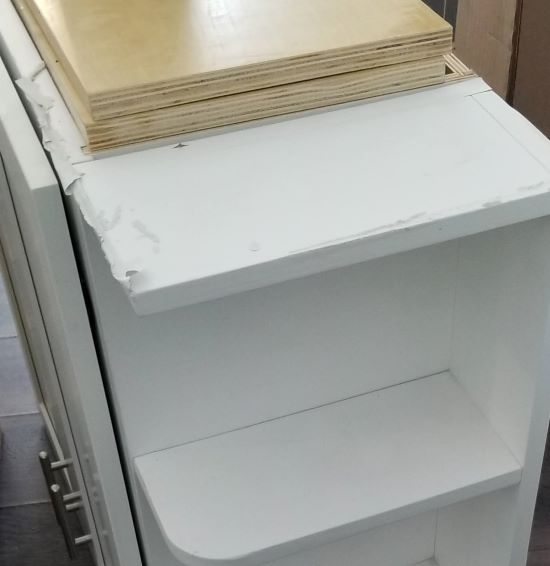
We got far more by working with an adjuster than we would have gotten on our own, because we had no idea what to ask for. As an example, left to my own devices, I would have been trying to dry out the kitchen cabinets with a towel and a blow dryer. By the end of the first day, though, the surface of cabinets the rip-out team had pulled down was visibly warped and peeling. They were unsalvageable, to say nothing of the wet drywall behind them, where dangerous mold could have grown over time.
When you’re talking about the scope of damage our home had sustained, it’s hard for someone who doesn’t work in the insurance or construction industry to quantify the loss. $30,000? $50,000? $150,000? It all sounded like “a lot” to me.
The rip-out alone ended up costing more than $30,000, and if we hadn’t hired an adjuster, there’s a good chance we may have needed to come up with that money out of pocket, with no notice. Since we woke up to the flooded home on a Saturday morning, I doubt we could have reached anyone from the insurance company to even help us get the rip-out started. Because the public adjuster coordinated the rip-out, we were never personally billed for these costs.
When it comes to the rip-out, one thing we were fortunate enough to know—but that many people may not realize—is that the policyholder is responsible for mitigating their damages. If we had fled the house with enough essentials to last the weekend and not dealt with any of the damage until after we got ahold of someone at our insurance company on Monday, our insurer might have fought us on covering some of the damage. Just waiting to deal with everything until we could contact the insurance company wasn’t an option.
… But There Was a Shortfall Between What We Received and What We Were Required to Spend on the Home Renovations
Here’s the downside of hiring a public adjuster: because a portion of your payout goes to the public adjuster, there’s a shortfall between that total settlement and what you actually receive. The insurance company isn’t going to pay for the cost of hiring a public adjuster, so that cost comes out of your claim.
In some cases, that might mean that you wait a little longer for non-urgent repairs and do them when you’ve saved up the money to pay the difference. In our case, we still owed enough money on the mortgage (having only lived in the house two years) that our check went directly to the mortgage company. The mortgage company would only disburse the insurance money in installments upon performing its own inspections and would not give us the full amount of money until the work was complete. Waiting on lower-priority rooms or repairs wasn’t an option.
The shortfall between the replacement cost paid by the insurance company and the final amount we received for the rebuild—minus the deductible, depreciation value, and public adjuster’s fees—added up to nearly $20,000. We had to make up that difference.
Was $125,000 of insurance money to rebuild our home still better than not having insurance at all? Definitely. Was it still better than we would have likely gotten without an adjuster? I absolutely think so.
But that $20,000 shortfall landed on us, so no, it definitely wasn’t a “free” home makeover.
We Chose a Licensed, Insured General Contractor Who We Really Trusted…
When it came time to finally rebuild our home, choosing someone to do all this work was daunting. I’ve dealt with contractors on far smaller projects in the past (at our previous home) who didn’t show up, ignored our calls, and even asked for more money without doing the work they had promised. I couldn’t imagine the type of chaos I’d have to expect from a contractor putting back together an entire house and implementing an estimate that consisted of hundreds of line items.
A neighbor on the social media website Nextdoor recommended a general contractor, so I reached out to them. My husband and I were impressed with their communication and follow-up. Most companies probably would have ghosted us during the three months it took for the insurance company to finally offer a settlement, but this company didn’t.
We met to go over the basics, then for a design consultation. We were impressed by the way the general contractor and his workers ran things and by their communication. They told us about a system they used called BuilderTrend that would allow us to manage communications, pay invoices, and see the project schedule. This gave us some reassurance that, for the first time in months, we would feel like we had some control over our life.
We signed the contract, and they quickly got to work.
… But There Are Always Some Bumps Along the Way in a Renovation
Our contractor has met or exceeded every expectation we’ve had, and his team has been great. Even so, the process of getting home hasn’t been smooth.
Days before we were scheduled to move in, the carpet installation team had a Covid outbreak. Supply chain delays have continued to impact things, too. A month after moving back in, we were still waiting on an elusive window that was somehow always “on the next truck” and some shower tile that kept arriving in the wrong shape or color to match what’s already been installed.
This is just life right now, especially when you’re undergoing a house renovation during a pandemic.
We Were Eager to Get Home, But Most of the Other Parties Involved Didn’t Care
Obviously, no one cared as much about getting us back home as we did. Still, I was surprised that other parties involved—the insurance company, the mortgage company, the township—consistently stalled things, keeping us displaced even longer.
Although the insurance company was required to pay for us to live elsewhere, it wasn’t eager to get us back in our house. We had to meet with multiple insurance adjusters, since not all adjusters handle large claims like ours. After a long stretch of no updates, our public adjuster learned that the insurance company’s large-claims adjuster had been in the hospital for weeks. The insurance company hadn’t bothered to appoint another adjuster to handle our claim in the meantime. Usually, a lot of the wait time is the back-and-forth negotiations between the insurer and the public adjuster, but in our case, it took over three months for the insurance company to even offer a settlement.
Once the insurance money was signed over to the mortgage company and placed in an escrow account, we had to deal with their loss draft department. They had no obligation to provide the money promptly and no negative consequences for not doing so. They continued to receive the same monthly mortgage payment from us, whether or not we actually got to live in the home.
We were assigned a “contact person” in the loss draft department but had no direct way to contact her. All communications went through a generic online messaging service with the loss draft department or a phone number that went directly to the loss draft department voicemail. Whether you called or emailed, you had to wait two business days for a reply. Often, our messages went unanswered for several days. Every communication seemed designed to take as long as possible and give the mortgage company more time before they had to part with our money.
Finally, there were the township’s delays. Our contractor warned us that our township is one of the more challenging municipalities in the area and would probably slow down our progress. He was right. Just getting a permit application reviewed took weeks.
What I’d Have Done Differently
Not Buying a Flipped Home
If I had to do things all over again, I would not buy a flipped house, period.

My husband and I thought we knew what we were getting into because our first home—a tiny but nicely renovated rancher about three miles from our current home—was a flip. The flippers had cut some corners on that house, but the problems we ran into were irritating inconveniences, not catastrophic events that left us displaced from home. Besides, all houses have their little “quirks,” right?
We went into buying this flipped home with realistic expectations, but the worst-case scenario was more than we’d bargained for.
I know not all house flippers do the kind of shockingly negligent things done by the company that flipped the house we purchased. The problem is that any flipped home you buy is a gamble, no matter how stunning it looks (and this home was stunning, so much so that it earned the nickname “the HGTV house” from the real estate agents who saw it).
I’m cutting my losses. I’ll never gamble on a flipped home again.
Not Thinking a Thorough Home Inspection Was All We Needed
When we bought our new home, we’d figured that as long as we had a thorough inspection done by a licensed home inspector, there wouldn’t be any surprises we couldn’t handle. Our home inspector was thorough, so much so that the seller raged at some of the findings in his report and then, grudgingly, addressed them.
But our home inspector couldn’t find what he couldn’t see: major problems hidden behind the walls and where the (faulty) plumbing connected behind and underneath the sink. He’d have had to rip apart the vanity and sink to have found the culprit that, two years later, would literally rain down havoc upon us. The only way he could have found the problems with the shower that would cause water damage to grow inside the walls and floor would have been to rip up the tiles.
Always get a home inspection when you purchase a house, but be aware that just because you got a home inspection doesn’t mean you’re in the clear.
Not Checking the Permits
I know exactly why people buy flipped homes. Renovations are expensive and time-consuming. The sheer volume of the decisions you have to make in renovating a home can be overwhelming. Buying a house that’s a flip cuts out all of those logistics. We’d wanted to buy something move-in-ready because we wanted a family home, not a project.
If you still want to buy a flipped house in spite of my cautionary tale, one way to protect yourself is to make sure the house flippers got permits for work they did (if it involved kitchens and bathrooms or other plumbing, electrical, or framing work).
The housing market wasn’t anywhere near as hot in 2019, when we bought our home, as it is right now. Still, our house had only been on the market for a week when we put in an offer, and we weren’t the first. We “won” a bidding war. (In hindsight, was it really a win?) It never occurred to us to check with the township to make sure the substantial renovations had been done legally, with the required permits. Even if it had, we would have missed out on the house if we had waited.
Selling points like the beautifully redone kitchen, stylish upstairs bathrooms, and finished basement were done “most likely without a construction permit,” according to a letter from our township building subcode official. Once the soaking-wet drywall came down, we learned that junction boxes had been dangerously and illegally buried under the sheetrock (“obvious illegal electrical wiring,” as the township official called it). Other problems that could potentially affect the safety of our family were hidden behind the walls, too.
Bringing the unpermitted work that had been done behind the walls up to code with the township cost more than $9,000 on top of the rest of the rebuilding costs. (We’re told that our insurance company should be required to cover these costs, but at this time, we’re still holding our breath.)
If the seller of a flipped house won’t show you the permits, you can put in a request with the municipality. I know the permitting process adds time and cost to the job, but if a professional house flipper didn’t bother to get the permits that are legally required for the work they did, there’s probably a reason—and it’s not just to avoid permit fees.
No permit means no inspection of what’s behind the walls. In our case, it meant there were hidden dangers that, experts told us, no licensed electrician or plumber would have signed off on.
Not Being Proactive About Water Damage Protection
I wouldn’t dream of not having smoke detectors in my home, even if I wasn’t legally required to do so. It never occurred to me that I could and should have a device in my home to prevent water-related losses, as well.
When this all happened, I knew that I never, ever wanted to take the risk that it could happen again. We hired a plumber we trusted to examine all of the plumbing that was now accessible, with the walls and ceilings open. We paid out of pocket—again, thousands of dollars not covered by the insurance company—to replace any substandard plumbing work in the house. We told our plumber how we wanted to make sure this never happened again, and he told us about smart leak detection systems.
They’re expensive, but having one would have prevented hundreds of thousands of dollars in damage, for about the cost of our insurance deductible ($1,000).
The “smart” component of the system is crucial because the water shutting off automatically is what would have saved us. There are plenty of systems that track water usage over time to identify small leaks, sometimes provided for free by your insurance company, but if we’d had one of these systems on the night of the catastrophic leak, it wouldn’t have helped us any. We would have slept right through the phone alert. (As it happens, I know people whose water usage trackers identified a minor outdoor leak in an underground sprinkler system but failed to respond to a sudden pipe burst.)
Our system is the LeakSmart, which can automatically shut off your water within five seconds of sensing a leak (that’s not just their marketing message—my husband and I tested it ourselves). We have sensors in every bathroom, in the kitchen, next to the washing machine, and in proximity to the water heater. A single drop of moisture is enough to activate the sensor, and when it does, it closes the water valve instantly.
What would our lives have been like the past 13 months if we’d had a smart water detection system last February? Instead of waking to the unchecked damage done by thousands of gallons of water gushing out of the broken pipe, we would have woken to a minor mess in the bathroom vanity and been mildly inconvenienced by the water being shut off. The LeakSmart would have paid for itself over and over and over. (Note: I’m not affiliated with LeakSmart in any way.)
I didn’t know this technology existed, so I can’t kick myself too hard for not investing in it before—but just like I’ll never buy another flipped house again, I’ll never skip having a smart leak detection system in place. A worn pipe can burst with no warning in a house that wasn’t flipped, too, and the damage can be just as massive.
Conclusion
Our family has been back in our home for over a month now, but “back to normal” is, realistically, months away.
The renovations aren’t finished, thanks largely to supply chain delays. We’re still awaiting the money that the mortgage company and the insurance company owe us to pay the last invoices and help us start building our finances back up.
We love the few upgrades we did make and the new wall colors and cabinet colors that make our home more, well, ours. We love that feeling of finally being home again.
All we’ve been through definitely wasn’t “worth it,” but we’re working hard to make the best of it all and to hopefully serve as a cautionary tale for anyone else going through a situation like ours.
